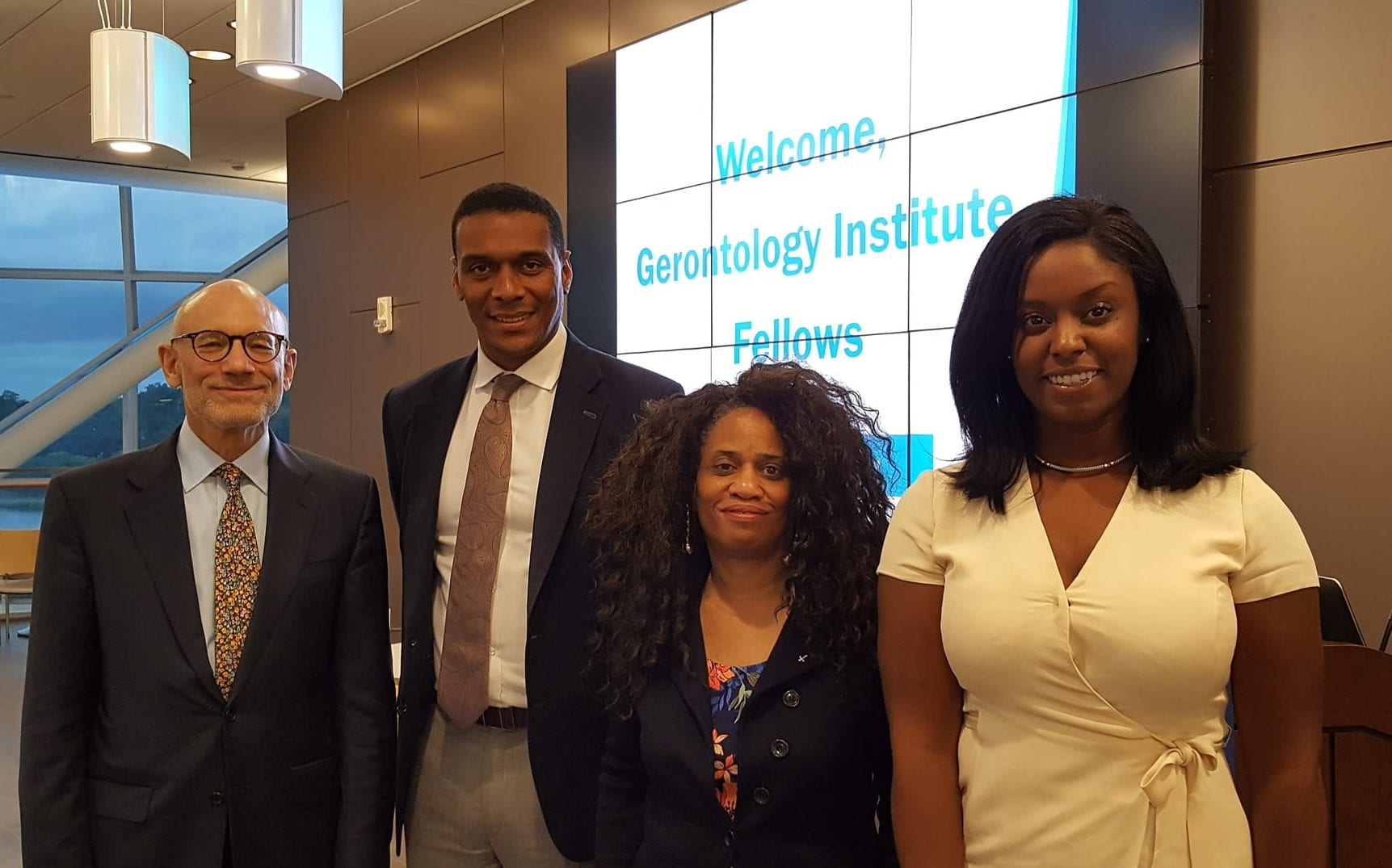
Left to right, Gerontology Institute Director Len Fishman, NIA Office of Special Populations Director Carl Hill, Gerontology Institute fellow Laurie Nsiah-Jefferson and guest Shayla Turnipseed.
Carl Hill got right to the point when he brought up the subject of research funding priorities at the National Institute on Aging.
“The ‘A’ in NIA stands for aging but it’s leaning toward Alzheimer’s,” Hill told more than 40 researchers and guests attending the first annual Gerontology Institute Fellows dinner at the University of Massachusetts Boston.
Hill, director of the NIA Office of Special Populations, spent a full day on the UMass Boston campus discussing funding opportunities within his institute and its $3.1 billion research budget. He pointed to the NIA’s $425 million funding increase specifically dedicated to Alzheimer’s disease research this year (by comparison, the NIA’s general appropriation for the year increased $84 million).
“We’re really part of the race for a cure,” he told the June 10 dinner audience. “We also want to understand the important determinants and factors that will help us slow the progression of Alzheimer’s.”
The NIA, one of many research organizations within the National Institutes of Health, funds Alzheimer’s research through its own divisions and in collaboration with other NIH institutes.
As director of NIA’s Office of Special Populations, Hill has a particular interest in health disparities that relate to Alzheimer’s disease. African-Americans are twice as likely to have the disease and Latinos 1.5 times more likely than Caucasians.
“Those disparities are important so understanding more about the factors behind them is important in Alzheimer’s research,” he said.
Earlier in the day, Hill met for two hours with 17 institute fellows – investigators from the Gerontology Department, other colleges on campus, and the LeadingAge LTSS Center @UMass Boston – to discuss their research interests and how they could fit with NIA funding priorities.
“The NIA can be intimidating, especially for young researchers,” said Gerontology Institute Director Len Fishman. “I think Dr. Hill’s friendliness and uncomplicated advice helped lower that barrier.”
Hill offered researchers a range of advice on understanding how the NIA works to take advantage of training opportunities and obtain funding for projects. That included:
- Look at how NIA is organized. Hill said the institute’s four divisions – Aging Biology Behavioral and Social Research, Neuroscience and Geriatrics and Clinical Gerontology – are clear guides about funding priorities. Start with that.
- Apply, apply, apply. “If you don’t apply, you don’t get funded,” said Hill. He urged younger researchers not to be intimidated by the process and said no investigators should get discouraged if initial proposals are turned down. Institute priorities and the people reviewing proposals can change over time. “You might get paid next time,” he said.
- Make early contact. Hill urged researchers to contact an NIA program official before submitting any funding application. He said a conversation about any project is important to make sure a proposal would fit into an area of interest for the institute.
- Take advantage of training resources. Hill mentioned several training opportunities at NIH but emphasized the Butler-Williams Scholars Program, a four-day annual event offering early career researchers lectures, seminars, mock peer reviews and consultation on the development of research interests.
- Stay engaged. Hill recommended subscribing to Inside the NIA, a blog dedicated to researchers interested in aging issues. He also pointed to the institute’s online listing of concept approvals, which announces new research areas of interest before they reach the funding opportunity announcement stage.

Leave a Reply